Sun news for May 2, 2024: Almost X flare producer departs on the southwest
Today’s top story: The hero of the week, active region AR3654, producer of an almost X flare late on April 30, an M9.5 flare now departs on the southwest limb (edge) carried out by the sun rotation.It’s position now, too foreshortened for a complete proper analysis of its magnetic configuration all indicates now showing a beta-delta configuration, still producing a couple of M flares during our observation period. Sun activity is back to moderate level but there are a couple of active regions filling in after AR3654 departure, they are AR3663 and AR3664 which are the lead flare producers of the period. Meanwhile, modeling and analysis of the long duration coronal mass ejection (CME) associated with a C5.8 flare on early May 1, a component Earth-oriented was found. A grazing may occur on May 4 and may bring chances for a G1 (minor) geomagnetic storm. Aurora chasers keep your cameras at hand
Last 24 hours: Solar activity during the past day was moderate with the production of four faint M flares. Between 11 UTC yesterday to 11 UTC today, the solar flare production was 13 solar flares: four Ms flares and nine C flares. The largest event was an M1.9 flare from active region AR3654 at 14:44 UTC on May 1. This a list of all four Ms during the past day. All M flare produced correspondent R1 (minor) radio blackouts over the sun lit Earth at the moment of the blast.
M1.8 flare by AR3654 at 14:32 UTC on May 1.
M1.9 flare by AR3654 at 14:44 UTC on May 1.(THE LARGEST)
M1.8.flare by AR3663 at 22:31 UTC on May 1.
M1.0 flare by AR3663 at 2:17 UTC on May 2.
The lead flare producer of the period was active region AR3663 on the northeast quadrant, who produced six flares, two Ms and four Cs, closely followed by sunspot region AR3664 blasting five flares during the past day. Currently the sun bears six labeled regions on its Earth-facing side. There is a newcomer on the solar disk now numbered AR3664 which came in thru the southeast limb (edge).
Next 24 hours: The chance for C flares is 99%. The chance for M flares is 55%. The chance for an X flare is 10%.
Next expected CME: After thorough modeling and analysis of a coronal mass ejection (CME) on May 1 associated with a long duration C5.8 flare on the southwest produced at 7:58 UTC on May 1, a component was found Earth-bound. A flanking edge shock may be possible with an arrival late on May 4. Analysis and modeling after April 30’s almost X flare, an M9.5 by AR3654, no CME was found Earth-oriented. No other coronal mass ejections (CMEs) were observed in available coronagraph imagery.
Current geomagnetic activity: Earth’s magnetic field is quiet at the time of this writing (11 UTC on May 2). Quiet to active periods are possible during the rest of the day today through May 3. Influence of high-speed solar wind from coronal holes combined with a mix of unobvious coronal mass ejections (CMEs). On May 4 a disturbance may escalate up to G1 (minor) geomagnetic storm levels with the possible arrival of a CME hurled by the sun on May 1. Aurora watcher keep your equipment at hand.
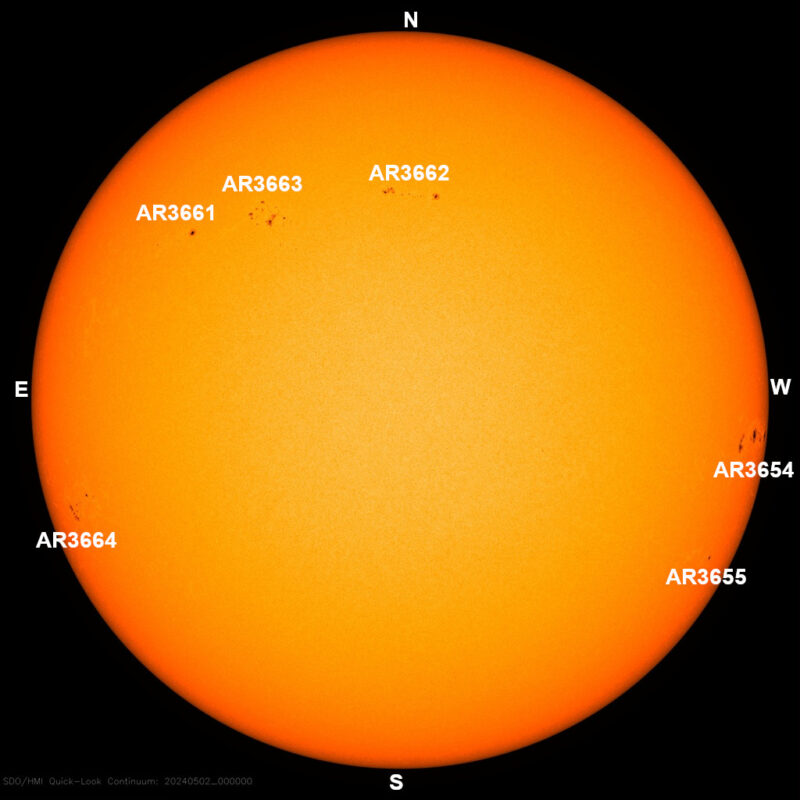
Sun news for May 1, 2024: Almost X flare! More to come?
Today’s top story: Sun-most-powerful-solar-flare” target=”_blank” rel=”noopener”>X flare. It happened late yesterday (23:23 UTC on April 30). The M9.5 flare produced an R2 (moderate) radio blackout over the Pacific Ocean west of Hawaii. It’s not uncommon for a large flare to follow an earlier large flare. Will we see a true X flare from AR3654? After yesterday’s blast, the region reduced its magnetic complexity. It’s now showing a beta-delta configuration, indicating a reduced potential for flaring. The sun’s rotation is about to carry this region out of view. It’s located close to the sun’s southwest limb (edge), and that location is making it difficult for experts to analyze its exact magnetic configuration. Stay tuned.
Last 24 hours: Sun activity is high with the production of an M9.5 flare. Between 11 UTC yesterday to 11 UTC today, the sun produced seven solar flares: four C flares and three M flares. The largest event was an almost-X flare, an M9.5 flare from active region AR3654 at 23:46 UTC on April 30. Prior to the M9.5, the region produced two small M flares, both of which – like the main flare – produced R1 (minor) radio blackouts over the Pacific Ocean. The lead flare producer was AR3654 with five flares, two Cs and the three Ms of the period, including the M9.5 flare. There are five regions on the Earth-facing side of the sun. There is a newcomer in the northeast quadrant, AR3663.
Next 24 hours: The chance for C flares is 99%. The chance for M flares is 55%. The chance for an X flare is 10%.
Next expected CME: A coronal mass ejection (CME) was observed in SOHO LASCO C2/C3 imagery. But this eruption was several hours after the M9.5. Analysis is ongoing to determine if there is an Earth-directed component. A possible CME from the M9.5 flare is still under analysis.
Current geomagnetic activity: Earth’s magnetic field is quiet at the time of this writing (11 UTC on May). An unsettled level was observed late yesterday. Kp = 4 threshold reached at 23:15 UTC on April 30. Active levels are anticipated during the day today. A G1 (minor) geomagnetic storm may occur later on today. These conditions may extend thru May 2 due to the influence of high-speed solar wind from coronal holes combined with the potential effects of multiple near-miss CMEs from the past several days. Clear skies to you, aurora-watchers!
spot region AR3654 has lived up to its potential and released an almost-
Sun news for April 30, 2024: See the 4 coronal holes! Plus, X-flare potential?
Today’s top story: Excitement is brewing on our star, with sunspot region AR3654 looking like a potential X flare producer. This giant sunspot region has continued to grow over the past day, and its beta-gamma-delta magnetic complexity indicates that it could produce some seriously large solar flares. Bring it on, AR3654! We’ve not seen an X flare since March 28, when our old friend AR3615 gave us an X1.1. AR3654 has a few days to bring the action before it rotates out of view over the southwestern limb (edge). Before it does, be sure to take a look at this sunspot through safe solar viewing or eclipse glasses – it’s big enough that you don’t need any magnification aid. What you won’t be able to see are the four coronal holes that are currently adding to the excitement on our sun. These are regions where the sun’s magnetic field opens into space, letting fast solar wind pour out. Since this wind can disturb Earth’s magnetic field, these coronal holes are giving us an increased chance for auroras at the moment. So, all we need now for an amazing auroral display is an Earth-bound coronal mass ejection (CME) from a big flare… We’re looking at you, AR3654!
Last 24 hours: Sun activity has been moderate over the past day with the production of an isolated M flare. Between 11 UTC yesterday to 11 UTC today, the sun released 13 solar flares: 12 C flares and one M flare. The largest event was an M1.6 flare from AR3654 at 1:14 UTC on April 30. The flare produced an R1 (minor) radio blackout over the Pacific Ocean at the boundaries of the Philippine Sea. The lead flare producer of the period was AR3654 with nine flares, including the M flare. There are currently five regions on the Earth-facing side of the sun, including newcomers AR3661 and AR3662.
Next 24 hours: The chance for C flares is 99%. The chance for M flares is 35%. The chance for an X flare is 5%.
Next expected CME: Modeling and analysis of an eruption in the northwest on April 29 at 9:09 UTC showed a coronal mass ejection (CME) with a potentially Earth-directed component. The impact would occur early on May 3. No other Earth-directed CMEs were observed in available imagery during the past day.
Current geomagnetic activity: Earth’s magnetic field is quiet at the time of this writing (11 UTC on April 30). Quiet-to-unsettled levels are anticipated for the rest of today. Quiet-to-active levels are anticipated on May 1 due to the influence of high-speed solar wind from the coronal holes combined with the potential effects of multiple near-miss CMEs from the past several days. Clear skies to you, aurora-watchers!
Sun news for April 29, 2024: Giant sunspot now as wide as 3 Earths
Sunspot region AR3654 continues to increase in size and maintain its magnetic complexity. We expected more to come from the region, and it did not disappoint. It fired off 15 of the observation period’s 17 flares, including two M flares. The region also grew from an area twice that of Earth to more than three times that of Earth. With your eclipse glasses, you should be able to glimpse it from Earth. AR3654 is located near the equator in the western hemisphere. This means that if the region erupts, there is a greater chance for solar stuff to head our way, especially solar energetic particles. Will AR3654 send more activity our way? Stay tuned.
Last 24 hours: Solar activity is moderate, with two M flares over the past 24 hours from AR3654. The sun released 17 solar flares15 C flares and two M flares. The largest event, an M3.7 flare, happened at 00:54 UTC on April 29. The second event, an M2.5 flare, happened at 00:33 on April 29. Both M flares produced an R1 (minor) radio blackout over the Pacific Ocean. AR3654 grew to an area three times that of Earth over the current observation period, 11 UTC yesterday to 11 UTC today. The region has maintained its delta region. Two filaments erupted from the northeast and southeast limbs (edges) around 6:52 UTC. There are six regions on the Earth-facing side of the sun now.
? ? Sun news for April 29, 2024: Giant sunspot continues to grow
? ? Sunspot region AR3654 continues to increase in size and maintain its magnetic complexity. We expected more from the region, and it did not disappoint.
? MORE at EarthSky: https://t.co/xD29wLfm4e pic.twitter.com/WKei6mFYrP
— Dr. C. Alex Young (@TheSunToday) April 29, 2024
Sun news for April 28, 2024: huge sunspot region poised for more action!
Sunspot region AR3654 doubled in size over the past day. It’s now about 2 planets in diameter. With your eclipse glasses, you might be able to glimpse it from Earth. At its location near the center of the sun’s visible disk, it could give us some excitement over the next few days. That’s because, besides growing in size, AR3654 has increased in magnetic complexity, indicating a potential for more flares. It already produced two M flares over the past day. Will we see more? Plus, given AR3654’s location on the sun’s visible disk, any eruptions will have a chance of sending sun-stuff our way. And that could mean more auroras in the days ahead. The region appears to have produced a small coronal mass ejection at around 11 UTC on April 27. That event could impact Earth in mid-to-late May 1. Stay tuned.
Last 24 hours: Solar activity is moderate, with two M flares over the past 24 hours from AR3654. The largest event, an impulsive M3.0 flare, happened at 21:29 UTC on April 27. The second event, an M2.1 flare, happened at 12:33 on April 27. AR3654 is now the largest sunspot region on the sun’s disk. Overall, flare production was lower over the past day (11 UTC yesterday to 11 UTC today), with two M and five C flares. A new Region, 3660, got its number. There are nine regions on the Earth-facing side of the sun now.
The sun in recent days
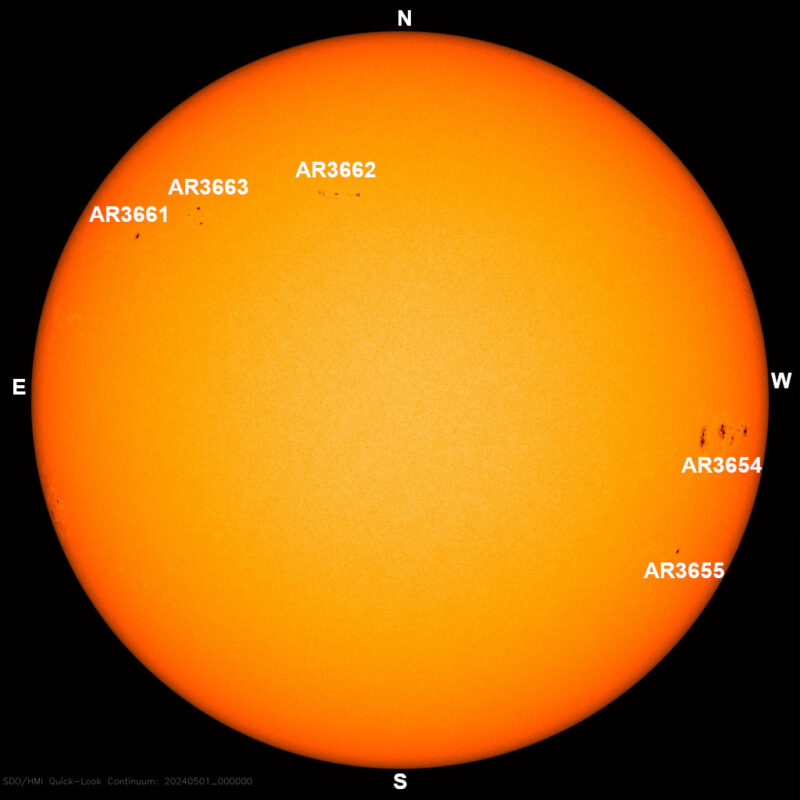
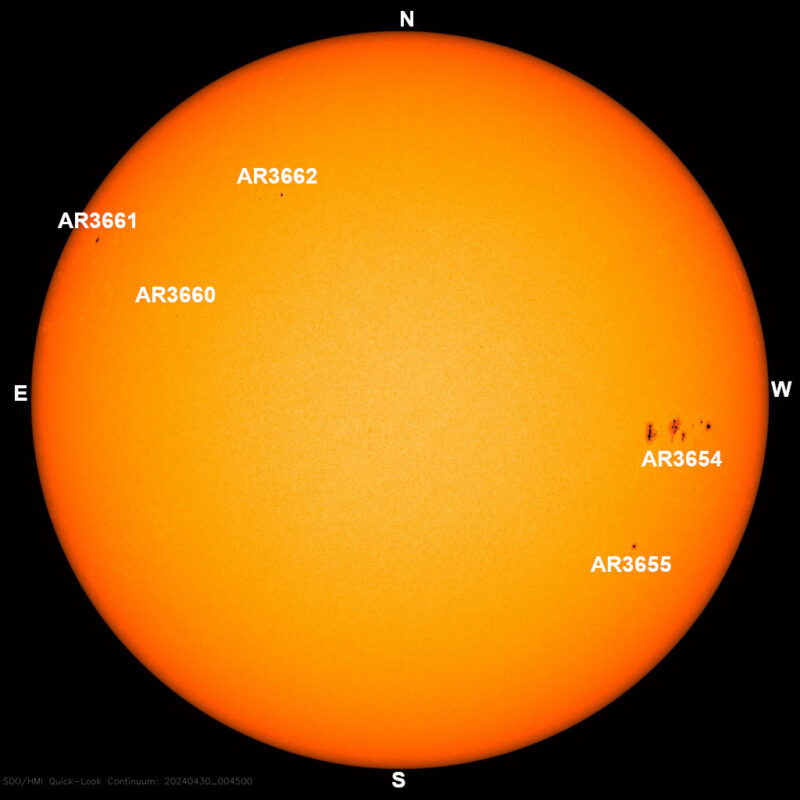
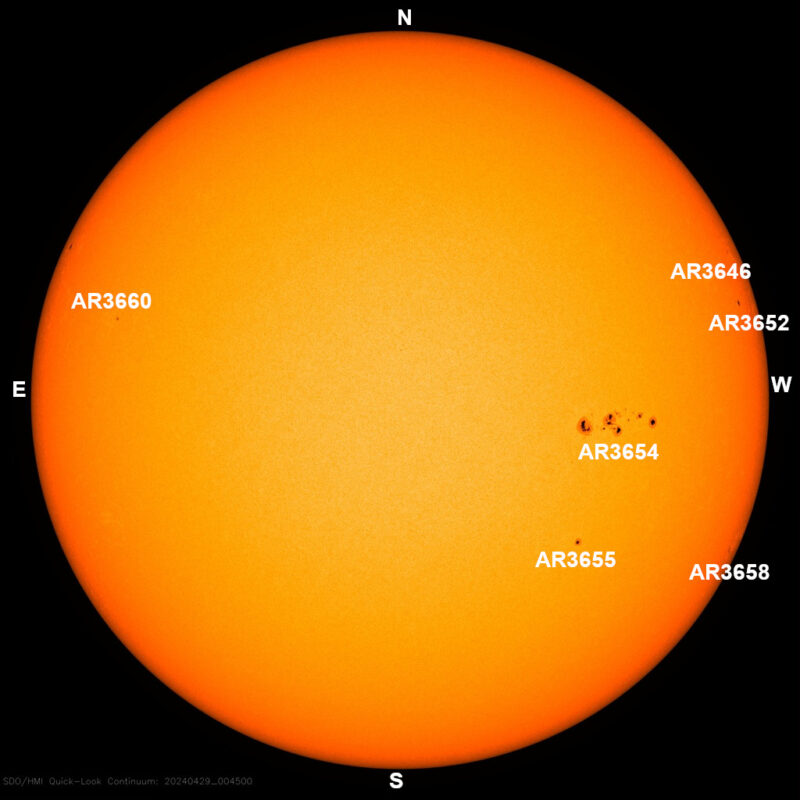
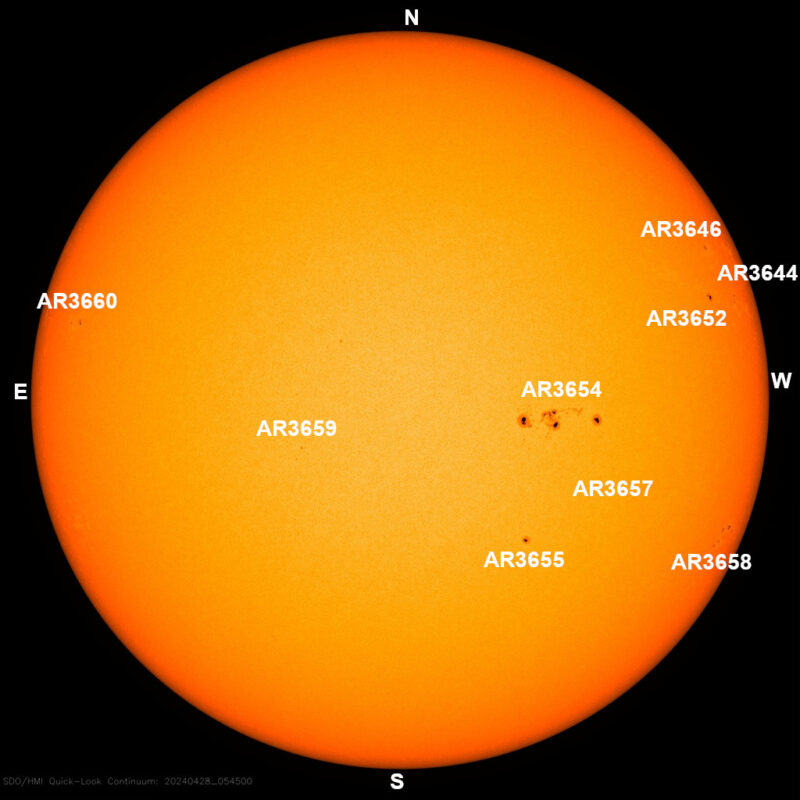

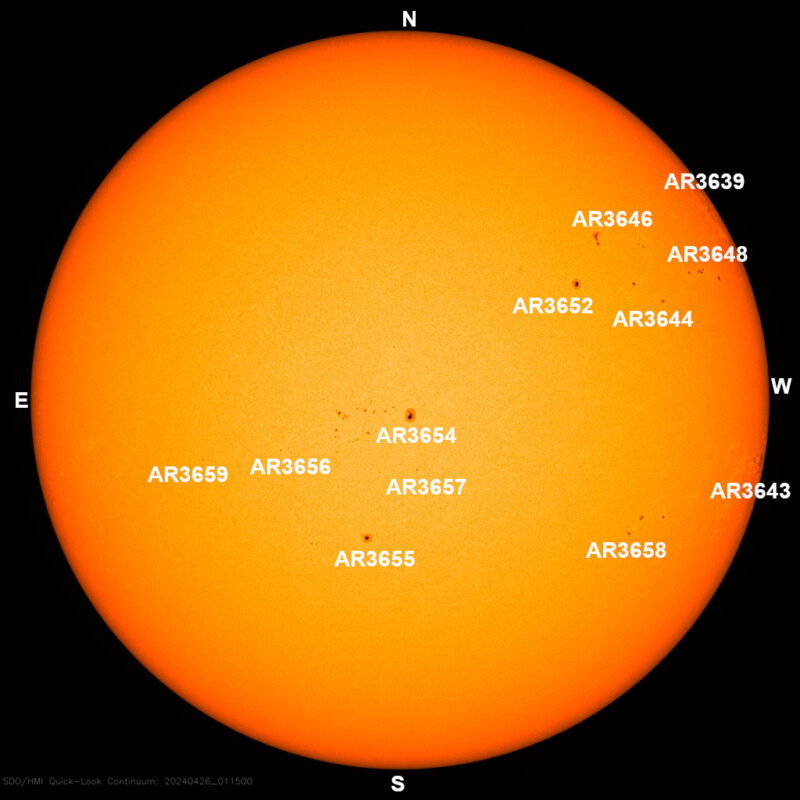
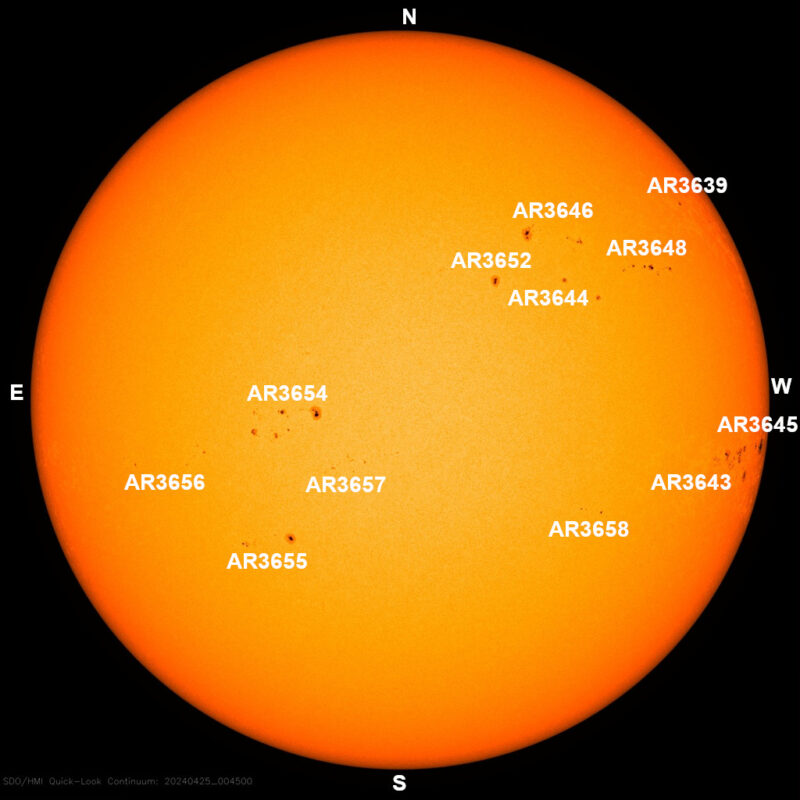
Sun images from our community
Are you a fan of sun images? We invite you all to send us your beautiful recent photos of sunspots and auroras. We love receiving them and sharing them! And to those of you who’ve already posted a photo to our community page, thank you.

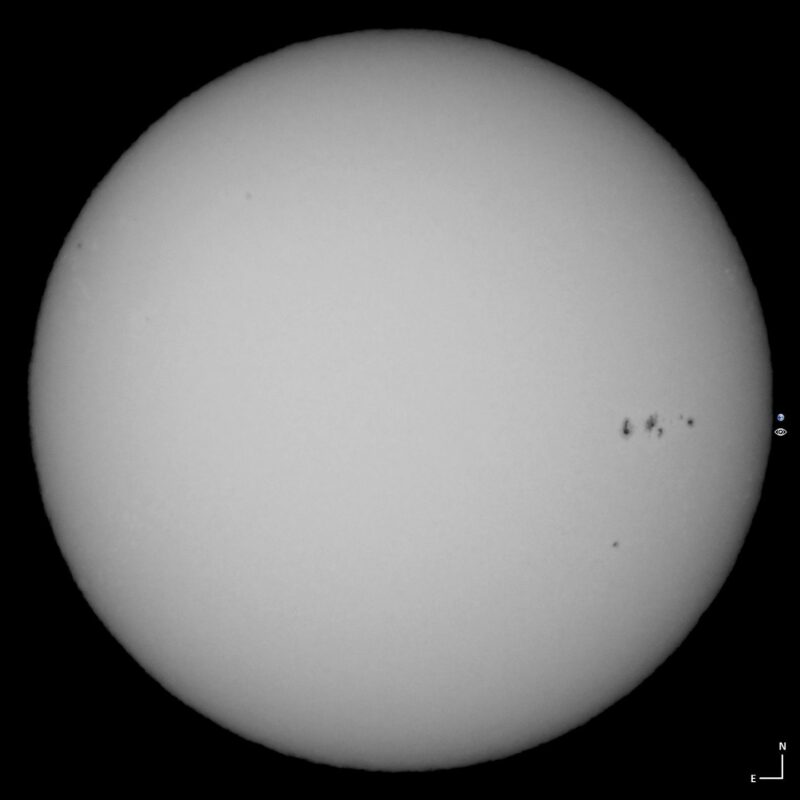
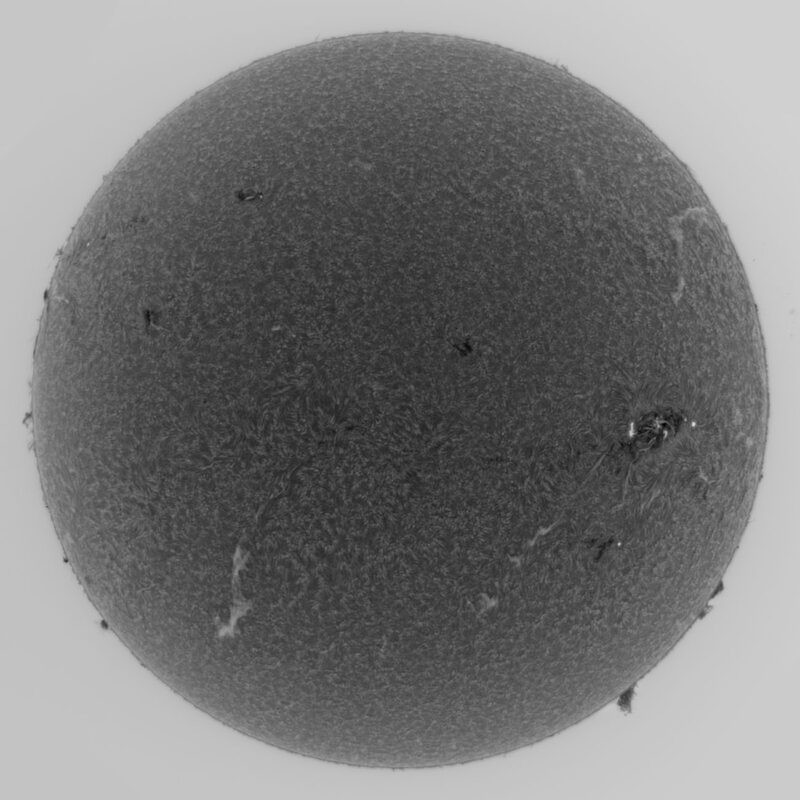

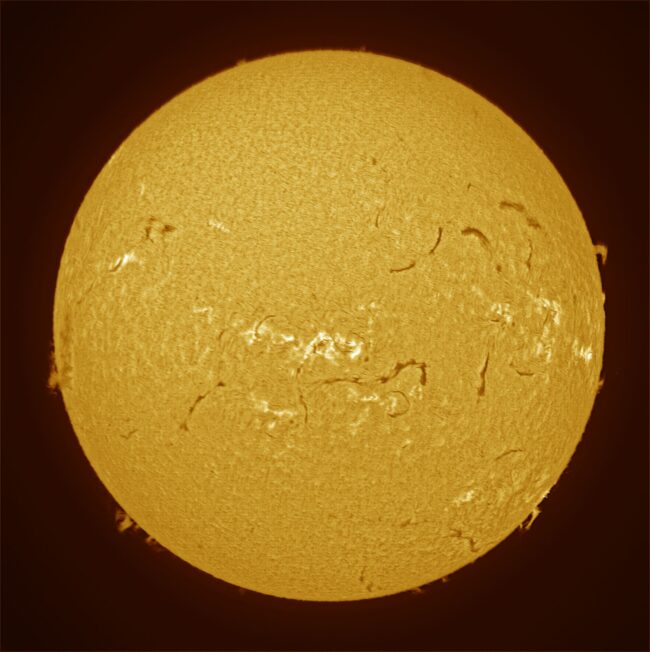
Bottom line: Sun news for May 1, 2024. Almost X flare! AR3654 produced an M9.5 flare — just shy of an X flare — living up to its potential.











